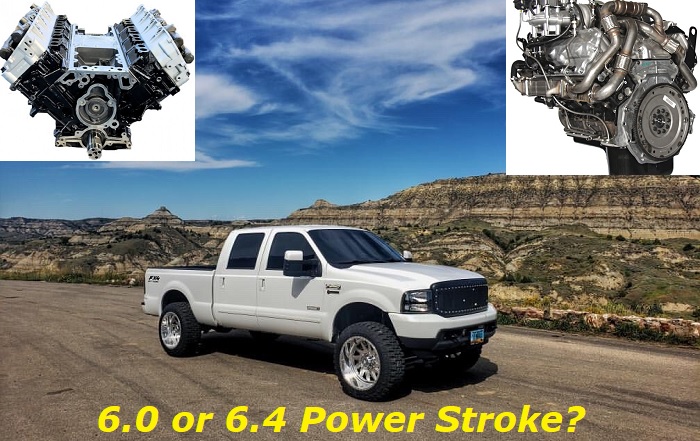Amid the rising costs of fuel and prices on vehicle parts, the most important thing that you should consider when buying a used auto is its engine. Diesel engines are the best choice when it comes to a variety of applications, especially in heavy-duty pickup trucks. Among the popular diesel engines that have withstood the test of time in this category are the 6.0 Power Stroke and 6.4 Power Stroke from Ford.
Key features and my opinion about the 6.0L engine
- Production years:2003-2009
- Average lifespan of 6.0L Power Stroke:320,000-350,000 miles
- Fuel supply type:direct injection
- Power range:325 hp
- Fuel efficiency:bad
- Engine block material:cast-iron
- Engine reliability score:low
- The most common problems:EGR cooler and oil cooler problems, fuel pump issues, head gasket problems, oil pump failing.
Key features and my opinion about the 6.4L engine
- Production years:2008-2010
- Average lifespan of 6.4 Power Stroke:230,000-250,000 miles
- Fuel supply type:Common Rail
- Power range:350 hp
- Fuel efficiency:bad
- Engine block material:cast-iron
- Engine reliability score:low
- The most common problems:oil consumption, turbo problems, EGR problems, DPF issues, high cost of maintenance, poor fuel economy.

6.0 Power Stroke
The 6.0 Power Stroke came as a replacement for the ever-popular 7.3 Power Stroke in compliance with the more stringent diesel emission standards and noise regulations in 2003, particularly in the state of California. The engine's production run went on until 2007 when it was eventually replaced by the 6.4 Power Stroke.
- Construction
The 6.0 Power Stroke features a combination of durable and light materials in ensuring optimal power delivery while keeping fuel consumption in check. It possesses a variable geometry turbocharger (VGT) and a V8 layout. The unit is made up of a cast-iron block, powdered-metal rods, and aluminum pistons. It also features an overhead valve (OHV) composed of four valves per cylinder on a single cam and hydraulic electronic unit injectors (HEUI) for fuel delivery.
The diesel engine has a displacement of 5,967 cc making it ideal for heavy-duty vehicles. It has a bore size of 3.74 inches and a stroke measuring 4.13 inches giving the engine better airflow, which is indicative of optimal power generation. This is complemented by a compression ratio of 18.0:1 meaning a high thermal efficiency that translates to a high level of mechanical energy.
- Power
In its stock configuration, the 6.0 Powerstroke delivers up to 325 hp at 3,300 rpm. The torque of the unit is rated at 560 lb-ft at 2,000 rpm from its 2003 to 2004 model, and later upgraded to 570 lb-ft at 2,000 rpm from 2005 onwards. If equipped in a capable heavy-duty truck, it can tow up to 15,000 lbs. of cargo or equipment.
So far, the highest tune given to the 6.0 Power Stroke netted 1,778 hp and 2,532 lb-ft of torque. It can be found on the 2006 Ford F-350 owned by the famous tuner Jesse Warren. The super duty pickup was featured at the 2016 Ultimate Callout Challenge where it displayed a jaw-dropping quarter-mile sprint of 10.05 seconds while topping at 135 mph.
- Fuel Economy
The fuel economy of the 6.0 Power Stroke can vary depending on a number of factors, but it is generally considered to be quite good. One of the main reasons for this is the fact that the engine is very powerful, yet still relatively efficient. In terms of actual mileage per gallon, the 6.0 Power Stroke typically gets between 20 and 25 miles per gallon on the highway and around 15 miles per gallon in the city. These numbers will obviously vary depending on the specific vehicle and driving conditions, but they give you an idea of what to expect, nonetheless.
- Reliability
The 6.0 Power Stroke has been tested and proven in popular vehicles such as the Ford F-Series and the Lincoln Navigator. It is a reliable engine that can provide drivers with many miles of trouble-free driving. If you maintain your vehicle properly and keep an eye on the temperature gauge, you should be able to enjoy many years of motoring pleasure with this. Coupled with proper maintenance and care, it can last over 180,000 miles according to customer reviews.
There are things that you should watch out for about the 6.0 Power Stroke though. Among the common complaints related to the engine is its tendency to produce more soot and particulates than other diesel units, which can lead to clogged filters and reduced performance over time. Additionally, the engine is known for being noisy due to its production of more vibrations than other diesels on the market. Several people criticize its fuel economy after years of use, too.
If any of the aforementioned problems are manifesting during your trip, make sure to address them immediately by bringing your vehicle to a qualified mechanic for repair or parts replacement. Make sure that your engine is serviced regularly as well to avoid or at least mitigate the risk of encountering these issues.
6.4 Power Stroke
The 6.4 Power Stroke was introduced in 2008 as the replacement for the older 6.0L engine. It was a significantly updated design compared to its predecessor, featuring new heads, block, pistons, and injection system, among others. The biggest change, however, was the integration of twin turbochargers, which greatly improved its performance and efficiency. Sadly, the manufacturing period of the engine was rather short, which only spanned until 2010.
- Construction
The 6.4 Power Stroke is a V8 engine that ditched its predecessor's VGT turbocharger in favor of the more advanced twin sequential turbos. It uses cast iron for its key components such as the engine block and cylinder head. The unit retains the 6.0L version's OHV valvetrain, but its fuel injection has been updated to a high-pressure common rail system with piezo-electric injectors.
This engine possesses a displacement of 6.369 cc, which is a significant leap from the 6.0L Power Stroke. There's a slight modification in its bore size at 3.87 inches but its stroke is the same as the model it replaced. For some reason, Ford reduced the compression ratio of the 6.4 Power Stroke to 17.5:1.
- Power
In its factory setting, the 6.4 Power Stroke generates 350 hp at 3,000 rpm and 650 lb-ft of torque at 2,000 rpm. The numbers are 25 hp and 80 lb-ft higher than the ones given off by a stock 2007 6.0L Power Stroke engine. Matched with a heavy-duty truck, such as Ford's Super Duty range, it can tow up to 16,000 lbs. of cargo or equipment. That's a thousand up from its precursor.
By far, the highest tunes achieved using the 6.4 Power Stroke are around 1,000 hp based on reports.
- Fuel Economy
The 6.4 Power Stroke is indeed a powerful engine, yet it boasts a great fuel economy as well. In fact, official estimates state that this engine can get up to 20 mpg in the city and 28 mpg on the highway. These are some impressive numbers, especially when you consider the sheer size and power of the engine and the trucks that carry it. But then again, these values may vary based on different conditions.
- Reliability
The 6.4 Power Stroke engine is well-regarded for its fuel efficiency, power, and reliability. Many users appreciate the engine for its towing capabilities and quiet operation.
Despite its many improvements, the 6.4L engine was plagued with reliability issues, particularly with the turbochargers and injectors. Ford issued several recalls and service bulletins over the years in an attempt to address these problems, but they never fully went away.
Another common problem with the engine is its premature wear. This can be caused by a number of factors, such as improper maintenance or using the wrong type of oil.
After years of use, owners have also complained about its excessive vibration. This can be due to several things, such as an imbalanced flywheel or an incorrect firing order.
If you notice any of these issues with your engine, it is important to take it to your nearest service center right away so they can properly diagnose and fix the problem. Moreover, nothing beats periodic maintenance even if there are no noticeable problems with your engine so that you can lessen the chances of its components breaking down and prolong its life.
With proper care and maintenance, many people have reported getting a range of between 150,000 to 200,000 miles with their 6.4 Power Stroke.
Which is the Right Engine for You?
Our verdict easily goes to the short-lived 6.4 Power Stroke. That's because it is superior in many ways to its predecessor, the 6.0 Power Stroke.
First off, it has 25 hp and 80 lb-ft more output in comparison to the stock configuration of the engine it replaced. Its towing capacity is also a thousand more.
Not only that, despite its higher performance figures, it has better fuel efficiency ratings at 20 mpg during city drives and 28 mpg on the highway as opposed to the 6.0L engine's 15 mpg in the city and 25 on the highway.
Sure, the 6.4 Power Stroke had its share of hiccups over the years, but so did the 6.0 Power Stroke. Nevertheless, the risk of such issues can be easily mitigated if not totally avoided with responsible use, regular cleaning, and periodic maintenance to ensure that your engine stays in its tip-top shape and for you to achieve the long mileage experienced by plenty of owners, which is around 250,000 to 350,000 miles.
About the authors
The CarAraC research team is composed of seasoned auto mechanics and automotive industry professionals, including individuals with advanced degrees and certifications in their field. Our team members boast prestigious credentials, reflecting their extensive knowledge and skills. These qualifications include: IMI: Institute of the Motor Industry, ASE-Certified Master Automobile Technicians; Coventry University, Graduate of MA in Automotive Journalism; Politecnico di Torino, Italy, MS Automotive Engineering; Ss. Cyril and Methodius University in Skopje, Mechanical University in Skopje; TOC Automotive College; DHA Suffa University, Department of Mechanical Engineering






Add comment